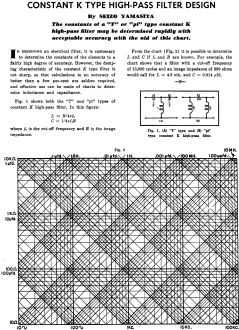|
Constant K filters
are not seen much in modern designs, but were some of the earliest types of
controlled impedance frequency selective networks.
George Campbell
is credited with inventing constant K filters in the early days of the last
century. He referred to the circuits as "electric wave filters." Campbell's
filters consisted of identical cascaded sections of "T" and "pi" inductor and
capacitor combinations, yielding arbitrarily high (theoretically) out-of-band
cutoff and band edge steepness. Less than ideal quality factor of the components
causes realizable filters to exhibit increasing insertion loss and reduction in
band edge corner sharpness as sections are added. Within a couple decades as
improved filters became necessary, other transfer functions like the
Butterworth, Chebyshev, Bessel, Gaussian, elliptical, and others were replacing
the constant K for their superior in-band and out-of-band amplitude, phase, and
group delay characteristics, depending on system requirements. This nomograph
from a 1952 issue of Radio & Television News magazine made constant K
filter design a cinch.
Constant K Type High-Pass Filter Design

Fig. 1 - (A) "T" type and (B) "pi" type constant K high-pass
filter.
By Seizo Yamasita
The constants of "T" or "pi" type constant K high-pass filter may be determined
rapidly with acceptable accuracy with the aid of this chart.
In designing an electrical filter, it is customary to determine the constants
of the elements to a fairly high degree of accuracy. However, the damping characteristic
of the constant K type filter is not sharp, so that calculations to an accuracy
of better than a few per-cent are seldom required, and effective use can be
made of charts to determine inductance and capacitance.
Fig. 1 shows both the "T" and "pi" types of constant K high-pass filter.
In this figure:
L = R/(4πf0)
C = 1/(4πf0R)
where f0 is the cut-off frequency and R is the image impedance.
From the chart (Fig. 2) it is possible to determine L and C if f0
and R are known. For example, the chart shows that a filter with a cut-off frequency
of 10,000 cycles and an image impedance of 600 ohms would call for L = 4.8 mH.
and C = 0.014 μfd.
Posted February 24, 2021
|










